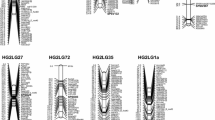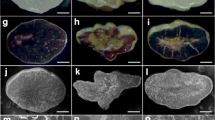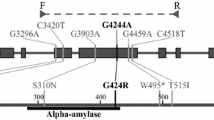Abstract
Main conclusion
A novel allele of the sugary-1 rice mutant was isolated. The single amino acid change led to isoamylase activity reduction and accumulation of high-molecular-weight phytoglycogen in seeds.
Abstract
A new sugary rice variety with an improved seed appearance has been isolated and designated Hemisugary1. This mutant, which was derived from Japonica-type cultivar Tsugaruroman treated with sodium azide, has about half the isoamylase activity of seeds in the original Tsugaruroman. The mutant also accumulates significant phytoglycogen, albeit approximately 40% of the total phytoglycogen in the existing sugary cultivar Ayunohikari which is defective in its most isoamylase activity. The site of mutation was identified using a re-sequence of the whole genome and a cleaved amplified polymorphic sequence (CAPS) marker. The hemisugary phenotypes of the F2 progeny were entirely consistent with the results of genotyping using the CAPS marker. Segregation analysis of the F2 population showed that the hemisugary phenotype was controlled by a single recessive gene, which was produced by a G → A single nucleotide polymorphism in the sugary-1 gene, resulting in a missense mutation from glycine to aspartic acid at amino acid position 333. Zymogram showed that this amino acid replacement resulted in a decrease in isoamylase activity with a concomitant reduction in the formation of isoamylase complexes. Phytoglycogen molecules from Hemisugary1 seeds were 3.5 times larger and contained more short glucan chains than did Ayunohikari seeds. Our data provide new insights into the relationship between isoamylase structure and phytoglycogen formation.







Similar content being viewed by others
Abbreviations
- CAPS:
-
Cleaved amplified polymorphic sequence
- DBE:
-
Starch debranching enzyme
- ISA:
-
Isoamylase
- PUL:
-
Pullulanase
References
Beatty MK, Rahman A, Cao H, Woodman W, Lee M, Myers AM, James MG (1999) Purification and molecular genetic characterization of ZPU1, a pullulanase-type starch-debranching enzyme from maize. Plant Physiol 119:255–266
Burton RA, Jenner H, Carrangis L, Fahy B, Fincher GB, Hylton C, Laurie DA, Parker M, Waite D, van Wegen S, Verhoeven T, Denyer K (2002) Starch granule initiation and growth are altered in barley mutants that lack isoamylase activity. Plant J 31:97–112
Bustos R, Fahy B, Hylton CM, Seale R, Nebane NM, Edwards A, Martin C, Smith AM (2004) Starch granule initiation is controlled by a heteromultimeric isoamylase in potato tubers. Proc Natl Acad Sci USA 101:2215–2220
Crofts N, Abe N, Oitome NF, Matsushima R, Hayashi M, Tetlow IJ, Emes MJ, Nakamura Y, Fujita N (2015) Amylopectin biosynthetic enzymes from developing rice seed form enzymatically active protein complexes. J Exp Bot 66:4469–4482
Doehlert DC, Knutson CA (1991) Two classes of starch debranching enzymes from developing maize kernels. J Plant Physiol 138:566–572
Fujita N, Kubo A, Francisco PB Jr, Nakakita M, Harada K, Minaka N, Nakamura Y (1999) Purification, characterization, and cDNA structure of isoamylase from developing endosperm of rice. Planta 208:283–293
Fujita N, Toyosawa Y, Utsumi Y, Higuchi T, Hanashiro I, Ikegami A, Akuzawa S, Yoshida M, Mori A, Inomata K, Itoh R, Miyao A, Hirochika H, Satoh H, Nakamura Y (2009) Characterization of pullulanase (PUL)-deficient mutants of rice (Oryza sativa L.) and the function of PUL on starch biosynthesis in the developing rice endosperm. J Exp Bot 60:1009–1023
Fujita N, Hanashiro I, Suzuki S, Higuchi T, Toyosawa Y, Utsumi Y, Itoh R, Aihara S, Nakamura Y (2012) Elongated phytoglycogen chain length in transgenic rice endosperm expressing active starch synthase IIa affects the altered solubility and crystallinity of the storage α-glucan. J Exp Bot 63:5859–5872
Hamada S, Suzuki K, Suzuki Y (2014) Development of a new selection method and quality improvement of sugary-1 rice mutants. Breed Sci 63:461–467
Hussain H, Mant A, Seale R, Zeeman S, Hinchliffe E, Edwards A, Hylton C, Bornemann S, Smith AM, Martin C, Bustos R (2003) Three isoforms of isoamylase contribute different catalytic properties for the debranching of potato glucans. Plant Cell 15:133–149
James MG, Robertson DS, Myers AM (1995) Characterization of the maize gene sugary1, a determinant of starch composition in kernels. Plant Cell 7:417–429
Kawahara Y, de la Bastide M, Hamilton JP, Kanamori H, McCombie WR, Ouyang S, Schwartz DC, Tanaka T, Wu J, Zhou S, Childs KL, Davidson RM, Lin H, Quesada-Ocampo L, Vaillancourt B, Sakai H, Lee SS, Kim J, Numa H, Itoh T, Buell CR, Matsumoto T (2013) Improvement of the Oryza sativa Nipponbare reference genome using next generation sequence and optical map data. Rice 6:4
Kubo A, Fujita N, Harada K, Matsuda T, Satoh H, Nakamura Y (1999) The starch-debranching enzymes isoamylase and pullulanase are both involved in amylopectin biosynthesis in rice endosperm. Plant Physiol 121:399–410
Kubo A, Colleoni C, Dinges JR, Lin Q, Lappe RR, Rivenbark JG, Meyer AJ, Ball SG, James MG, Hennen-Bierwagen TA, Myers AM (2010) Functions of heteromeric and homomeric isoamylase-type starch-debranching enzymes in developing maize endosperm. Plant Physiol 153:956–969
Lee EY, Whelan WJ (1971) Glycogen and starch debranching enzymes. In: Boyer PD (ed) The enzymes. Academic, New York, pp 191–234
Manners DJ (1989) Recent developments in our understanding of amylopectin structure. Carbohydr Polym 11:87–112
Miura K, Uehara Y, Kobayashi A, Ohta H, Shimizu H, Sasahara H, Fukui K, Komaki Y, Goto A, Shigemune A, Otsuki H (2007) A new rice variety “Ayunohikari”. Bull Natl Agr Res Cent 9:1–16
Nakamura Y (1996) Some properties of starch debranching enzymes and their possible role in amylopectin biosynthesis. Plant Sci 121:1–18
Nakamura Y, Umemoto T, Ogata N, Kuboki Y, Yano M, Sasaki T (1996a) Starch debranching enzyme (R-enzyme or pullulanase) from developing rice endosperm: purification, cDNA and chromosomal localization of the gene. Planta 199:209–218
Nakamura Y, Umemoto T, Takahata Y, Komae K, Amano E, Satoh H (1996b) Changes in structure of starch and enzyme activities affected by sugary mutants in developing rice endosperm: possible role of starch debranching enzyme (R-enzyme) in amylopectin biosynthesis. Physiol Plant 97:491–498
Nakamura Y, Kubo A, Shimamune T, Matsuda T, Harada K, Satoh H (1997) Correlation between activities of starch debranching enzyme and α-polyglucan structure in endosperms of sugary-1 mutants of rice. Plant J 12:143–153
Pan D, Nelson OE (1984) A debranching enzyme deficiency in endosperms of the sugary-1 mutants of maize. Plant Physiol 74:324–328
Peng C, Wang Y, Liu F, Ren Y, Zhou K, Lv J, Zheng M, Zhao S, Zhang L, Wang C, Jiang L, Zhang X, Guo X, Bao Y, Wan J (2014) FLOURY ENDOSPERM6 encodes a CBM48 domain-containing protein involved in compound granule formation and starch synthesis in rice endosperm. Plant J 77:917–930
Slattery CJ, Kavakli H, Okita TW (2000) Engineering starch for increased quantity and quality. Trends Plant Sci 5:291–298
Smith AM, Denyer K, Martin C (1997) The synthesis of the starch granule. Ann Rev Plant Physiol Plant Mol Biol 48:67–87
Takashima Y, Senoura T, Yoshizaki T, Hamada S, Ito H, Matsui H (2007) Differential chain-length specificities of two isoamylase-type starch-debranching enzyme from developing seeds of kidney bean. Biosci Biotechnol Biochem 71:2308–2312
Utsumi Y, Nakamura Y (2006) Structural and enzymatic characterization of the isoamylase1 homooligomer and the isoamylase1-isoamylase2 heterooligomer from rice endosperm. Planta 225:75–87
Utsumi Y, Utsumi C, Sawada T, Fujita N, Nakamura Y (2011) Functional diversity of isoamylase oligomers: the ISA1 homo-oligomer is essential for amylopectinbiosynthesis in rice endosperm. Plant Physiol 156:61–77
Yano M, Isono Y, Satoh H, Omura T (1984) Gene analysis of sugary and shrunken mutants of rice. Japan J Breed 34:43–49
Zeeman SC, Umemoto T, Lue WL, Au-Yeung P, Martin C, Smith AM, Chen J (1998) A mutant of Arabidopsis lacking a chloroplastic isoamylase accumulates both starch and phytoglycogen. Plant Cell 10:1699–1711
Zeeman SC, Kossmann J, Smith AM (2010) Starch: its metabolism evolution, and biotechnological modification in plants. Ann Rev Plant Biol 61:209–234
Acknowledgements
This work was supported by a grant from Takano Life Science Research Foundation, Hirosaki University Grant for Exploratory Research by Young Scientists, and the Japanese Society for the Promotion of Science [KAKENHI, Grant Number 19K05989 (to SH)]. The work was carried out in part at the Teaching and Research Center for Bio-coexistence and Gene Research Center of Hirosaki University. We would like to thank Enago (www.enago.jp) for the English language review.
Author information
Authors and Affiliations
Corresponding author
Additional information
Publisher's Note
Springer Nature remains neutral with regard to jurisdictional claims in published maps and institutional affiliations.
Electronic supplementary material
Below is the link to the electronic supplementary material.
Rights and permissions
About this article
Cite this article
Takahashi, S., Kumagai, Y., Igarashi, H. et al. Biochemical analysis of a new sugary-type rice mutant, Hemisugary1, carrying a novel allele of the sugary-1 gene. Planta 251, 29 (2020). https://doi.org/10.1007/s00425-019-03321-0
Received:
Accepted:
Published:
DOI: https://doi.org/10.1007/s00425-019-03321-0




